When and how to plant tomatoes in a polycarbonate greenhouse
In Russia, tomatoes are grown in almost every summer cottage. Planting tomatoes in a greenhouse in spring is a common thing for many summer residents. And this is not surprising: the vegetable is not only tasty, but also healthy. Red fruits are rich in folic acid, vitamins A and C, lycopene, lutein, beta-carotene. Regular consumption of fresh tomatoes strengthens the immune system, normalizes blood pressure and lowers blood cholesterol levels. After all, tomatoes are delicious!
However, given the southern origin of the culture, it is not always possible to get a good harvest of healthy vegetables. Tomato is a capricious culture; it is not easy to provide optimal conditions for the formation and ripening of fruits in a temperate climate. In the article we will talk about how and when to plant tomatoes in a greenhouse or polycarbonate greenhouse correctly.
The content of the article
- Pros and cons of growing tomatoes in a polycarbonate greenhouse
- Choosing a variety of tomatoes for a polycarbonate greenhouse
- Soil preparation
- Seed preparation
- Growing seedlings
- Transplanting seedlings and processing a polycarbonate greenhouse before planting tomatoes
- Caring for tomatoes in the greenhouse
- Conclusion
Pros and cons of growing tomatoes in a polycarbonate greenhouse
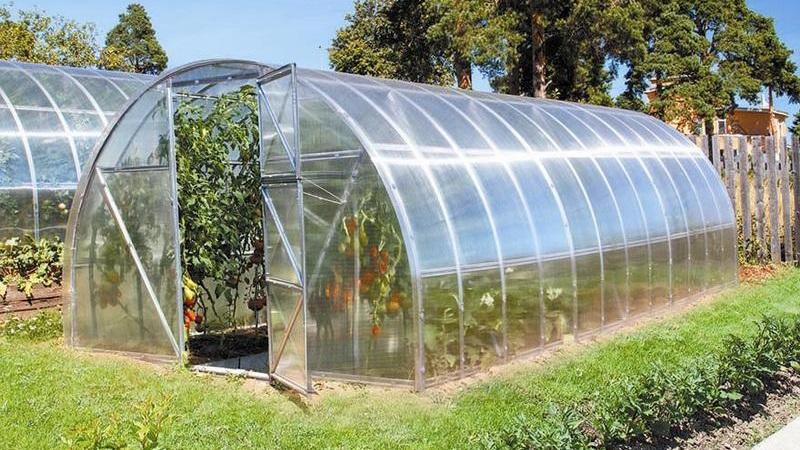
Polycarbonate is a relatively new material. It began to be used in the construction of greenhouses only a few years ago. What are the advantages and disadvantages of growing tomatoes in a polycarbonate greenhouse? First, let's list the pros:
- polycarbonate transmits sunlight well, and good lighting is an important condition for increasing tomato productivity;
- the material is distinguished by high heat-saving properties, therefore, in the cold season, the cost of heating the greenhouse will be less;
- polycarbonate is strong and durable, which cannot be said about film shelters and glass greenhouses;
- condensation does not collect on the surface of the polycarbonate greenhouse, which is important when growing tomatoes - moisture that gets on the leaves and flowers harms the plants;
- if necessary, the polycarbonate cover can be easily disassembled and moved to a new place.
Despite the many advantages, polycarbonate greenhouses also have some disadvantages:
- natural air circulation in polycarbonate greenhouses is practically absent, therefore they are regularly and thoroughly ventilated;
- in a closed warm space, microorganisms multiply rapidly, so polycarbonate structures are regularly disinfected;
- polycarbonate transmits the sun's rays worse than glass, therefore, shelters made of this material are placed only in open, unshaded areas.
Choosing a variety of tomatoes for a polycarbonate greenhouse
So, we plant tomatoes in a polycarbonate greenhouse. First, choose the right culture. What kind tomato seeds are better to choose? Hybrids are ideal for greenhouses and greenhouses. They are disease resistant and produce a stable crop.
Council. In polycarbonate greenhouses, there are practically no insects that pollinate plants, so choose self-pollinating varieties and hybrids of tomatoes.
On average, the yield of greenhouse tomatoes is 12-15 kg per sq. m. Tomato hybrids, specially bred for cultivation in greenhouse conditions, yield up to 20 kg of yield per square meter.
But remember that no seed is harvested from hybrids. The seeds are either sterile or lose their quality in the second generation. Before planting, these seeds are not treated to stimulate growth or disinfect. All the necessary procedures have already been carried out at the factory.
Attention! If it is indicated on the seed package that the plants are bee-pollinated, then such tomatoes are not planted in the greenhouse. They are intended for outdoor use.
The timing of fruit ripening depends on the characteristics of the variety. Undersized (determinant) varieties reach technical ripeness earlier than tall ones (indeterminate).
When choosing a variety also pay attention to the size of the tomatoes. Large juicy fruits are good for making salads, and medium and small ones are good for canning.
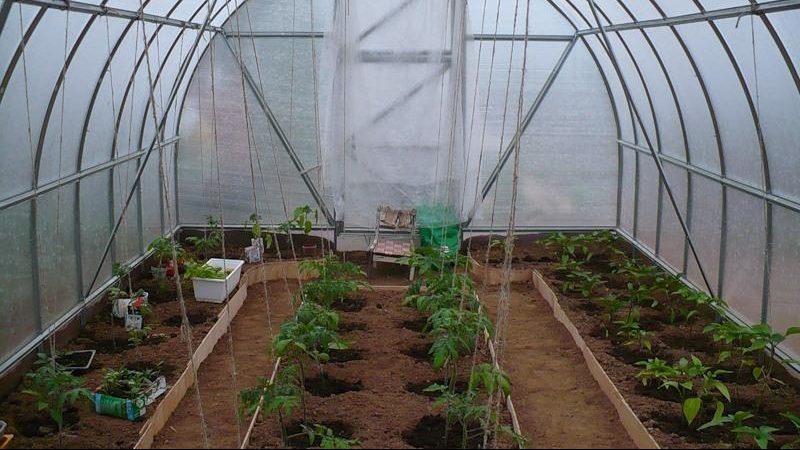
Soil preparation
The preparation of the soil in the greenhouse begins in the fall. First, the land is cleaned of plant residues and debris and dug up. If the soil is heavy, then add sand (1 bucket per sq. M). Tomatoes love light, fertile soil.
With increased acidity, lime is additionally added (500 g per square meter). The introduction of sand and lime is combined with digging.
From organic fertilizers, manure, compost, humus are used. The dug and fertilized soil is left in this form for the winter. Frost will destroy pathogens and pests.
In the spring, mineral fertilizers are additionally applied (nitrate, superphosphate, potassium chloride). When applying fertilizers, follow the manufacturer's recommendations. An excess of nutrients in the soil will lead to a violent growth of the green mass of the bush, and the fruits will not be tied.
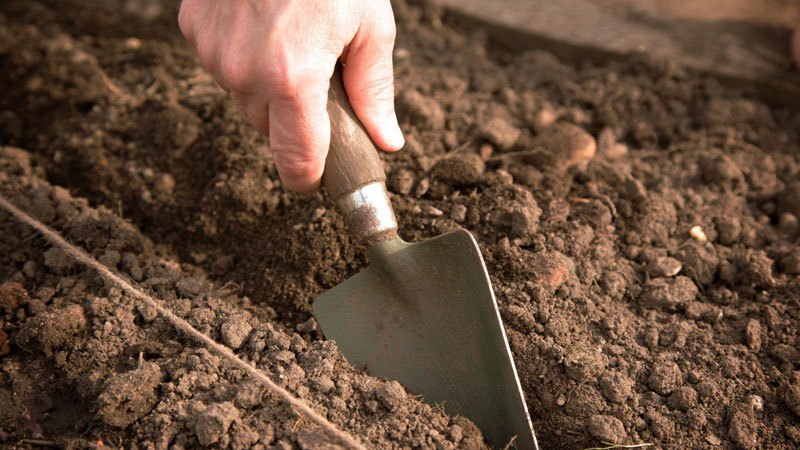
Seed preparation
Prepare not only the soil for planting, but also the planting material. Preparation consists of several sequential stages:
- Soak in salt water. This simple procedure allows you to reject small and empty seeds - they will float to the surface. Seeds that have settled to the bottom are removed, washed in clean water and dried.
- Warming up. Tomato seeds are heated for a week, gradually increasing the temperature to 50-60 ° C. The seeds of the hybrids are not heated.
- Disinfection. Seed material is kept in a solution of potassium permanganate for 20-30 minutes. The procedure reduces the risk of infection of seedlings with pests and diseases.
- Soaking in nutrient solution... The purpose of the event is to increase productivity. Industrial preparations (for example, "Virtan-Micro", "Epin", "Immunocytofit") or folk remedies (potato or aloe juice) are used as a nutrient fluid. After processing the seeds with a nutrient mixture, they are dried without rinsing in water.
- Hardening. Seedlings from hardened seeds tolerate temperature changes better. For hardening, the seeds are alternately exposed to cold and heat. First, the hatched tomato seeds are placed in the refrigerator for 12 hours. Then it is kept at room temperature for 12 hours. The procedure is repeated 2-3 times.
Prepared seeds give faster and more friendly shoots than those that have not been trained. In addition, plants from prepared seeds are less sick and bear fruit better.
Growing seedlings
Seeds for seedlings are sown 45-60 days before the expected date of planting in the greenhouse. That is, if it is planned to plant plants in a permanent place at the end of May, then planting seeds is carried out at the end of March.
For seedlings, containers with a height of at least 10 cm are used. The pots or boxes are filled with soil by 2/3. The prepared seeds are planted to a depth of about 1 cm. The best temperature for seed germination is + 25 ° C.
Tomato seedlings are demanding on lighting. If natural light is not enough, then they provide backlighting using special lamps. The optimal daylight hours for tomatoes are 12-16 hours.
After the emergence of seedlings, the air temperature is lowered to + 14 ... + 16 ° C. So the seedlings will get stronger and will not stretch out. After 1-2 weeks, the temperature is raised to + 18 ... + 20 ° C.
Water the seedlings sparingly, about once a week. For glaze use water at room temperature.
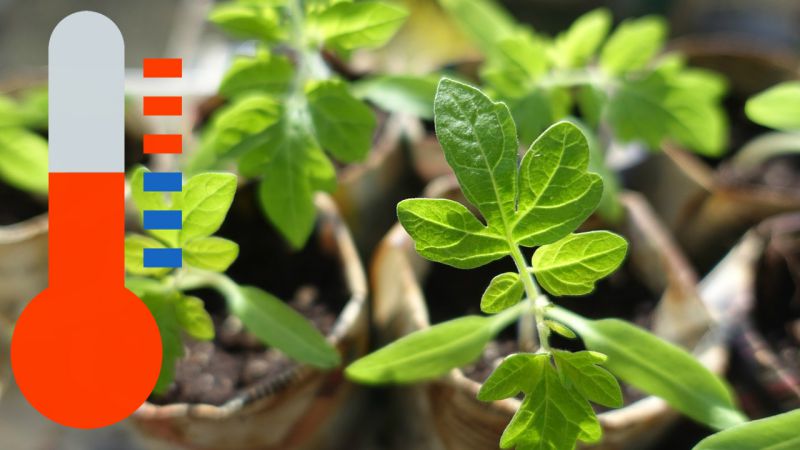
Transplanting seedlings and processing a polycarbonate greenhouse before planting tomatoes
For cultivation in polycarbonate greenhouses, tomato seedlings are prepared in the same way as for cultivation in the open field. Correct seedlings are strong, healthy plants prepared for temperature extremes by hardening.
Important! Seedlings with signs of diseases or those affected by pests are destroyed, preventing them from entering the greenhouse.
If the infection enters the greenhouse, it will not be easy to get rid of it later. In a warm, enclosed space, microorganisms multiply rapidly.
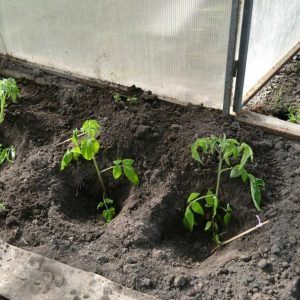
Before planting plants, the walls and frame of the greenhouse are cleaned of dust and dirt. To protect against diseases and pests, the structure is disinfected (with a solution of copper sulfate, Bordeaux mixture, hydrogen peroxide, etc.).
Particular attention is paid to ventilation. The vents must ensure sufficient air circulation inside the structure.
Planting seedlings in a greenhouse
Tomatoes are planted in the ground only after the soil has warmed up to + 12-15 ° C, because this is a southern culture that loves warmth... If the soil is not warmed up enough, the roots will start to rot and the plants will die.
For warming up and disinfection, the soil is watered with a strong hot solution of potassium permanganate. Immediately before planting, a liter of warm water is poured into each hole.
Seedlings are planted in cloudy weather so that the plants take root faster.
Distance between plants
What is the distance to plant tomatoes in the greenhouse? When determining the distance between plants, they are guided by the manufacturer's recommendations varieties.
The landing pattern will be as follows: undersized early ripening varieties, forming 2-3 stems, are arranged in 2 rows. The distance between them is maintained at 55-60 cm.At least 35-40 cm is left between the plants.
Tall varieties of culture, forming 1 powerful stem, are planted denser. A distance of 45-50 cm is maintained between the rows. Between the plants - 25-30 cm.
Caring for tomatoes in the greenhouse
Seedlings planted in a permanent place need care. Caring for tomato bushes consists in watering, making top dressing, tying up.
Watering
The first time tomatoes are watered in a greenhouse immediately after planting in the ground. Water it abundantly to deeply wet the soil - then the plants will take root well and begin to grow rapidly.
The second time the tomatoes are watered no earlier than a week later. During subsequent watering, they are guided by the drying of the topsoil. The next day after moistening, the soil is loosened, providing oxygen access to the root system.
Important! After watering, the greenhouse is ventilated. Otherwise, condensation will form on the polycarbonate walls and roof, and the air humidity will exceed the norm.
The increased humidity of the soil and air negatively affects the growth of the crop. Excessive moisture provokes the development of disease and makes pollination difficult.
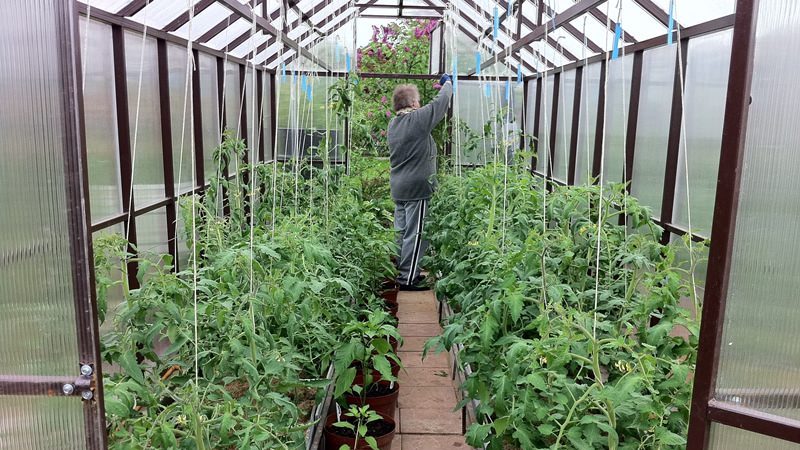
Tying
Tying the tomatoes provides better lighting and air flow to the bush. In addition, plants spread out on the ground are susceptible to fungal infections.
Bushes are tied up one week after planting. Wooden stakes, metal or plastic pins are used as support. Plants are tied to a support with a rope or wire.
When growing tall varieties, a trellis garter is used. In a row, stakes are installed at a distance of 1.5-2 m and wire or twine is pulled on them in several horizontal projections. Each bush is tied to a horizontal support with twine or wire.
Fertilization
The first time tomatoes in a greenhouse are fed when planting seedlings. Humus, compost, ash are poured into the prepared holes. The first two fertilizers contain minerals. The ash contains a lot of micro and macro elements that are necessary for tomatoes for full growth, flowering and fruit formation.
Important! If the soil in the greenhouse has already been prepared and fertilized, then no fertilizing is carried out during planting.An excess of nutrients will cause the plants to fatten.
The next time the tomatoes are fed in 2-3 weeks with mineral fertilizers. They are bred in water according to the instructions and the plants are watered.
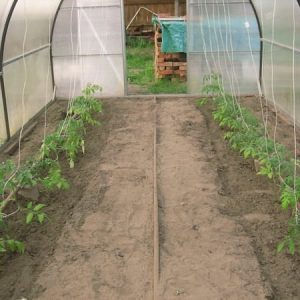
Tomatoes are then fertilized during mass flowering. In 10 liters of water, dilute 1 tbsp. l. potassium sulfate, 0.5 liters of poultry manure and the same amount of liquid mullein. 1 liter of the prepared solution is added under each bush.
The last feeding of tomatoes is carried out after the mass formation of fruits. This will speed up fruit ripening and harvesting. To prepare a nutrient solution in 10 liters of water, dissolve 2 tbsp. l. superphosphate and 1 tbsp. l. liquid sodium humate.
Conclusion
Planting tomatoes in a greenhouse requires a competent approach. To harvest a rich harvest, it is important to choose the right variety, prepare planting material and soil, clean and disinfect the structure. It is also important to follow the rules of caring for plants in a polycarbonate greenhouse.
Compliance with the cultivation technology will allow you to grow enough fruits for fresh consumption and for canning.